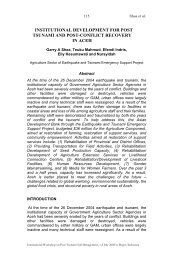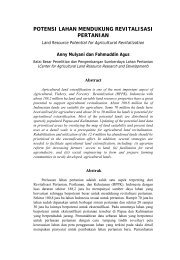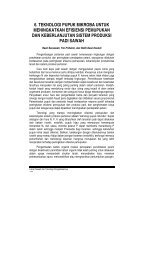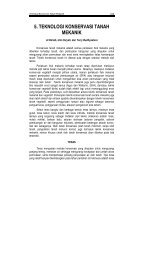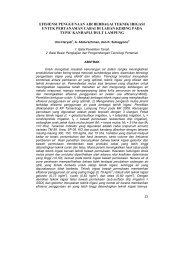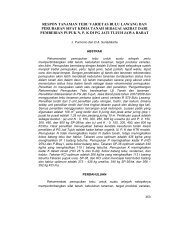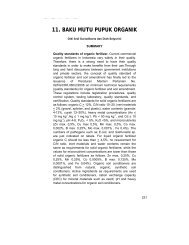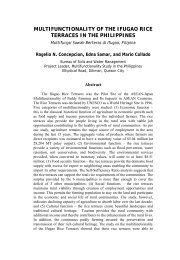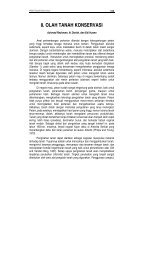Proceedings - Balai Penelitian Tanah
Proceedings - Balai Penelitian Tanah
Proceedings - Balai Penelitian Tanah
Create successful ePaper yourself
Turn your PDF publications into a flip-book with our unique Google optimized e-Paper software.
105<br />
Sembiring et al.<br />
lowland rice to other commodities, or simply abandoned the land.<br />
Despite the fact that salinity has been destroying the productive<br />
capacity of coastal areas(as well as at the drier eastern part of<br />
Indonesia) in Indonesia for decades, it is only relatively recently that<br />
we have recognized the extent of the problem and, unfortunately,<br />
efforts made on national scale to slow the process is limited (or<br />
none?). As a result, personnel responsible to handle salinity problems,<br />
especially in rice cropping, are still scarce. It should be much better if<br />
salinity problem in Indonesia is handled on national scale. Madamba<br />
(1981) have suggested that national agricultural research systems in<br />
the developing countries have a key role to play in agricultural and<br />
rural development and in advancing the economic status of the<br />
developing nations. More over, new technologies have better chances<br />
for nationwide adaptation on account of ongoing national program for<br />
intensifying production (Lantican 1981).<br />
Tsunami in NAD and other rice production areas, on December 2004,<br />
awakened agronomists that salinity must be seriously considered in<br />
order to revitalize rice production, especially lowland rice; not only in<br />
NAD but also in other production areas significantly affected by<br />
salinity. Some international organizations have been directly engaged<br />
in NAD to restore rice cropping in tsunami-affected areas. It was<br />
evident that salinity is a complex problem and needs special and<br />
comprehensive efforts, especially for rice crop restoration after<br />
tsunami. From field monitoring to tsunami-affected areas, it was also<br />
seen that researches are required in revitalization of the affected<br />
areas. In addition, there is a need to have experienced staff available<br />
to solve problem, to transfer techniques and knowledge on salinity<br />
remediation and to evaluate management strategies which at least<br />
restore productivity to pre-tsunami levels.<br />
Because research must be shared with the end users, it is extremely<br />
important to develop effective strategies for lateral, downward, and<br />
even upward communication. In other words, a good research<br />
strategy must be coupled with communication and adoption efforts. As<br />
has been pointed out by Flores (1981), the primary justification for<br />
research is how it can change the lives of people for the better. For<br />
this to happen, results of research must reach the people who shall<br />
ultimately make use of it. Research is of little use until it is applied for<br />
productive purposes.<br />
The ACIAR project, SMCN/2005-118, was a comprehensive and<br />
integrated effort in restoring rice cropping in NAD after tsunami,<br />
fulfilled justifications mentioned above. The project activities such as<br />
field trials and monitoring directly engaged with farmers and involved<br />
them in field activities in their local area. The capacity building of<br />
extension staff and technical knowledge developed in this project<br />
improved the advice and information available to farmers and<br />
International Workshop on Post Tsunami Soil Management, 1-2 July 2008 in Bogor, Indonesia



